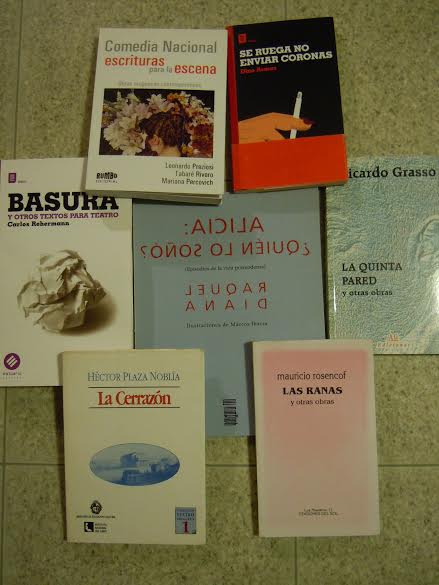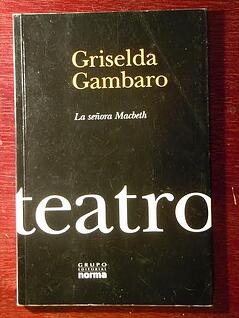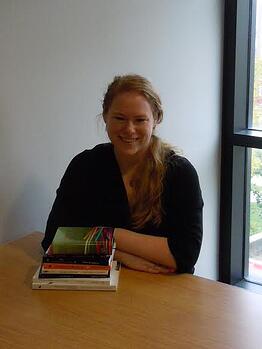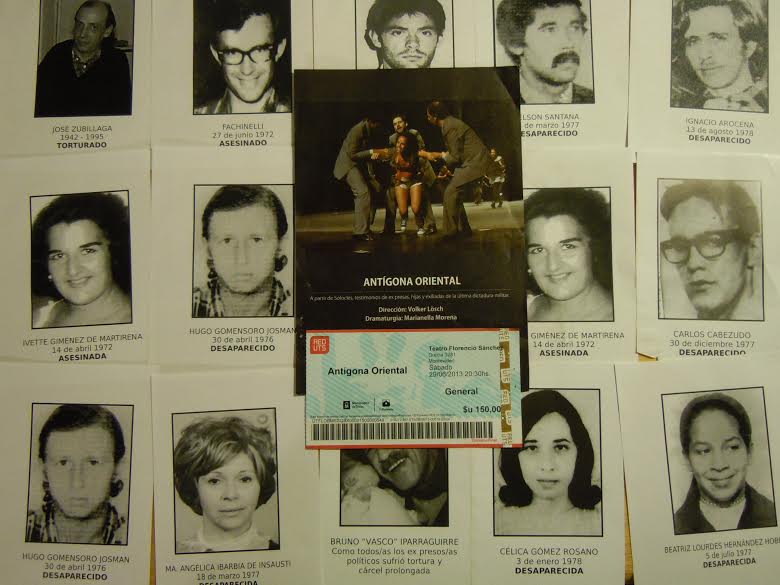Katya Soll is a doctoral candidate at the University of Kansas. She won first prize in the 2014 National Collegiate Book Collecting Contest with her essay, "Dictatorship, Recovery, and Innovation: Contemporary Theater of the Southern Cone." She has amassed an impressive collection of playbooks, programs, and performance tickets that document her immersion into a remarkable theatrical culture. Her scholarship illuminates a quintessential example of how a people reckon with a difficult history through art and creativity. We were lucky enough to get the chance to interview her about her work and collection.
Your paper focuses on the theatre of South America’s Southern Cone. Can you elaborate a bit on the region and its culture for our readers?
 The term “Southern Cone” refers to the southernmost countries of South America: Argentina, Uruguay, Chile, and Paraguay. My research and collection focus on the first three of those countries. All three are of primarily European heritage, though Chile still has more of an indigenous presence than Argentina and Uruguay. All three countries also underwent repressive, conservative military dictatorships in the 1970s and 1980s and still are dealing with questions of memory, justice, and impunity.
The term “Southern Cone” refers to the southernmost countries of South America: Argentina, Uruguay, Chile, and Paraguay. My research and collection focus on the first three of those countries. All three are of primarily European heritage, though Chile still has more of an indigenous presence than Argentina and Uruguay. All three countries also underwent repressive, conservative military dictatorships in the 1970s and 1980s and still are dealing with questions of memory, justice, and impunity.
What are some of the challenges and rewards of maintaining a bilingual collection?
The biggest challenge is access: most of the plays that I study are not easily available in the U.S. Sites like eBay and Amazon are incredibly useful, but you have to already have a good idea of what you are looking for. If you want to just browse and look at new plays and authors, you really need to go to the country itself (or have access to an amazing library!).
Your essay cites one play that’s a sort of modern retelling of Macbeth. Are you surprised by some of the vast cultural influences in Latin American theatre?
Not at all. Although the U.S. likes to pride itself on being a unique nation of immigrants and cultural mixing, the reality is that Latin America has the same history of diverse immigration from European and Asian countries along with varied indigenous and African populations. Just looking at the names of playwrights from the Southern Cone, it is easy to see both the original Spanish influence (Marco Antonio de la Parra, Florencio Sánchez) and also Italian (Griselda Gambaro, Lucía Laragione) and other European influences (Ariel Dorfman, Eduardo Pavlovsky, Egon Wolff, Roberto Arlt, Mauricio Rosencof, Rafael Spregelburd). It is not surprising, therefore, that many of the same cultural influences present in U.S. theatre are also present in Latin America, from the ancient Greeks, to Shakespeare and the Spanish Golden Age, to Brecht and Pirandello. In fact, if you go into a typical bookstore in Latin America, the theatre section will usually focus on these texts over regional authors. Latin America takes part in the same Western theatrical traditions, while blending them with local and regional influences. I also saw plays that adapted Antigone, Othello, Don Quixote, and many other “universal” classics.
the reality is that Latin America has the same history of diverse immigration from European and Asian countries along with varied indigenous and African populations. Just looking at the names of playwrights from the Southern Cone, it is easy to see both the original Spanish influence (Marco Antonio de la Parra, Florencio Sánchez) and also Italian (Griselda Gambaro, Lucía Laragione) and other European influences (Ariel Dorfman, Eduardo Pavlovsky, Egon Wolff, Roberto Arlt, Mauricio Rosencof, Rafael Spregelburd). It is not surprising, therefore, that many of the same cultural influences present in U.S. theatre are also present in Latin America, from the ancient Greeks, to Shakespeare and the Spanish Golden Age, to Brecht and Pirandello. In fact, if you go into a typical bookstore in Latin America, the theatre section will usually focus on these texts over regional authors. Latin America takes part in the same Western theatrical traditions, while blending them with local and regional influences. I also saw plays that adapted Antigone, Othello, Don Quixote, and many other “universal” classics.
What was it like to spend three months in the Southern Cone, both as a collector and as a student of theatre?
As a collector, getting to go to the Southern Cone was a wonderful opportunity. Few plays from the Southern Cone are published outside of the region (only some texts by the most canonical authors or their most famous plays). So actually going to bookstores, cultural centers, and publishers in these countries is one of the best ways to explore new texts and find lesser-known works.
 As a student of theatre, this trip was a dream come true. Theatre is a live medium, so you can only truly understand a country or city’s theatrical culture by going there and experiencing it for yourself. In each city, I was able to learn not just about particular productions, but common theatrical styles, the diversity of theatres and plays, the popularity of theatre and degree of involvement of the public—all different aspects of how a theatrical culture is created and fits into the community.
As a student of theatre, this trip was a dream come true. Theatre is a live medium, so you can only truly understand a country or city’s theatrical culture by going there and experiencing it for yourself. In each city, I was able to learn not just about particular productions, but common theatrical styles, the diversity of theatres and plays, the popularity of theatre and degree of involvement of the public—all different aspects of how a theatrical culture is created and fits into the community.
Buenos Aires, Argentina, for example, has a thriving theatrical community of both commercial and independent theatres. As a city of over 13 million people, it can easily support a vast array of theatrical productions. Many independent theatres show different productions every day in rotating repertory; with curtain times ranging from 7:30 to 11:00, I could easily see 10 plays or more in a week. Montevideo, Uruguay, on the other hand, is a much smaller city (only about 1.5 million people), so there are fewer theatres and companies, and many only run shows on the weekends. Santiago, Chile, is in the middle both in size (5-6 million) and theatrical variety. Historically, the universities were vital to the development of independent, high-quality theatre in Chile, and they continue to play an important role.
Many of the plays in your collection are only a few years old. What’s it like to be at the forefront of a book’s audience?
The challenge and the privilege is that nothing is established yet; each play could become the next  renowned and enduring text or be completely forgotten. As a live medium, theatre is by its nature ephemeral, so my collection of programs captures a moment in a city’s theatrical history. The plays that have been published have already achieved a certain degree of prominence and permanence, but also face that uncertainty regarding whether or not they will be produced again or in other cities/countries, whether they will be studied or reprinted, and so on. So each text is full of potential and possibility that may or may not ever be realized.
renowned and enduring text or be completely forgotten. As a live medium, theatre is by its nature ephemeral, so my collection of programs captures a moment in a city’s theatrical history. The plays that have been published have already achieved a certain degree of prominence and permanence, but also face that uncertainty regarding whether or not they will be produced again or in other cities/countries, whether they will be studied or reprinted, and so on. So each text is full of potential and possibility that may or may not ever be realized.
Are there any authors you study that deserve much more attention than they receive?
Most of the authors that I study deserve much more attention. One of the things that inspired me to study Spanish and Latin American theatre was the realization that so few of these plays and playwrights are studied and performed in the English-speaking theatrical community. A student in a theatre department can study theatre from the U.S., the U.K., Germany, France, Italy, Russia, and so on, but if you want to study Spanish and Latin American theatre, you have to go to a Spanish department. One of my goals for the future is to work in the translation and publication/performance of the plays that I work with.
Your paper had a sharp historicist lens. What are some of the political and social preoccupations that have struck you during your academic career?
As a researcher, I am always fascinated by plays that examine gray areas and blind spots in social perception. Since I study dictatorial and post-dictatorial eras, black-and-white dichotomies are very common: us-them, victim-perpetrator, left-right, good-evil. Many of the plays in my collection try to complicate or unpack those simplistic views, by looking at the psychology of the torturer or the collaborator or at society’s passive complicity, for example. In all of these countries, people with opposing views were frequently disappeared, with no information given to their families about their whereabouts.
Yet with the justifiable focus on the cases of the disappeared, the experiences of survivors and their families are often de-privileged or left out of the conversation, something which many of the plays I work with attempt to rectify. I was particularly struck during my trip to Chile, which coincided with the 40th anniversary of the coup d’etat, by how many plays commemorating those events addressed the issue of gaps in the conversation; many playwrights and companies mentioned that they were specifically attempting to explore an area of the dictatorial experience that has not traditionally been discussed: internal exile (where dissidents were sent to remote areas to live), clandestine life, collaboration, reluctant members of the armed forces, among others.
What are some of your rarest volumes? What are some of your most beautiful and striking volumes?
 One of my favorite volumes is Alicia: ¿quién lo soñó? (Episodios de la vida posmoderna). [Alice: Who Dreamed It? (Episodes from Postmodern Life)], by Uruguayan playwright Raquel Diana. It is particularly unique, because it is a completely illustrated edition, with imaginative drawings on every page, intertwining with the text. So the published version of the play creates a completely different artistic performance than the original theatrical version. This genre-bending form is perfect for a play that combines, among other things, references to Lewis Carroll’s Alice in Wonderland, TV detective dramas, Jonathan Swift, and cartoon superheroes. When I was preparing my bibliography for my collection, I discovered that it was published in a limited 500-edition run, of which mine is copy #495.
One of my favorite volumes is Alicia: ¿quién lo soñó? (Episodios de la vida posmoderna). [Alice: Who Dreamed It? (Episodes from Postmodern Life)], by Uruguayan playwright Raquel Diana. It is particularly unique, because it is a completely illustrated edition, with imaginative drawings on every page, intertwining with the text. So the published version of the play creates a completely different artistic performance than the original theatrical version. This genre-bending form is perfect for a play that combines, among other things, references to Lewis Carroll’s Alice in Wonderland, TV detective dramas, Jonathan Swift, and cartoon superheroes. When I was preparing my bibliography for my collection, I discovered that it was published in a limited 500-edition run, of which mine is copy #495.
What was it like seeing the many performances during your time in Latin America?
It was absolutely thrilling! I was able to see an extraordinary range of plays, from the realistic to the innovative, from one-man/woman intimate productions to an eighty-person circus-style show. It also required a great deal of planning; I needed to choose from a myriad of possible productions so that I could make it to all the shows I wanted to see, and work out which ones were close to each other and timed out correctly so that I could see multiple productions in a day. It could get a little exhausting, (especially in Buenos Aires, where I was also teaching two classes and helping to lead a study-abroad program), but it was completely worth it!
Is there anyone or anything in particular that turned you on to collecting?
Both of my parents are avid book-lovers, so reading and owning books has always been an important part  of our lives. I am also inspired by the Latin American theatre collection of George Woodyard. He was a professor at my university (the University of Kansas) and a foundational force in the field of Latin American theatre. He donated a collection of over 1,000 pieces, collected over more than 40 years, to the university library. Building that kind of collection, by visiting countries and developing relationships with scholars and playwrights, is something that I aspire to someday.
of our lives. I am also inspired by the Latin American theatre collection of George Woodyard. He was a professor at my university (the University of Kansas) and a foundational force in the field of Latin American theatre. He donated a collection of over 1,000 pieces, collected over more than 40 years, to the university library. Building that kind of collection, by visiting countries and developing relationships with scholars and playwrights, is something that I aspire to someday.
Are there any books in your collection that you’re fond of that were not relevant to your paper?
Absolutely. While my research and my collection focus on questions of repression and memory, these are obviously not the only subjects being explored in contemporary theatre. Even the term “contemporary theatre” can be limiting or misleading: does it refer only to recently written plays or also to contemporary productions of older plays?
One of my favorite performances did not fit the more narrow definition of my collection either in terms of topic or when it was written: a production of the 1937 play La isla desierta (The Deserted Island) by Roberto Arlt by the Teatro Ciego (Blind Theatre). Most of the cast members are blind and the production is set in total darkness, so the audience experiences the play entirely through sound and smell. It was a completely immersive experience unlike anything I had ever participated in before. Other productions dealt with historical figures, contemporary issues such as poverty and marginalization, or even the Palestine-Israeli conflict. So even though my key area of interest as a scholar is the dictatorships and their legacy, as a collector, I try to include a broader picture of the contemporary theatrical scene in these countries.
Every book comes with a story. Do any of your books come with an especially interesting one?
The book that really sparked my interest in this field and was the first book in my collection was La señora Macbeth (Lady Macbeth) by Griselda Gambaro. I came across it on my first trip to South America in the summer after my freshman year of college. I was double-majoring in Theatre and Spanish, but had not yet read any Spanish-language plays. I went to a bookstore to browse their theatre section and came across this play. My parents introduced me to Shakespeare when I was three or four, so I am a lifelong Shakespeare fan. Finding this adaptation of Macbeth seemed perfectly serendipitous: it brought together my interest in languages and other cultures with one of my favorite authors.
What was one of the most memorable days of book hunting you’ve ever had?
On one of my first days in Montevideo, I decided to wander the main commercial district and see what I could find. My first stop was a large bookstore a block from where I was staying in the historic Ciudad Vieja (Old City). While I generally considered myself lucky to come across half-a-dozen new plays or playwrights at any particular bookstore, this one had a five-foot shelf devoted exclusively to Uruguayan theatre. I never made it to another store that day. I ended up spending the rest of the day sipping coffee in their café and looking through new plays, and I came back several more times! A substantial portion of my Uruguayan play collection comes from that bookstore.
Many thanks to Katya Soll for granting us this interview. Please feel free to respond to her and her collection in the comments section below.








